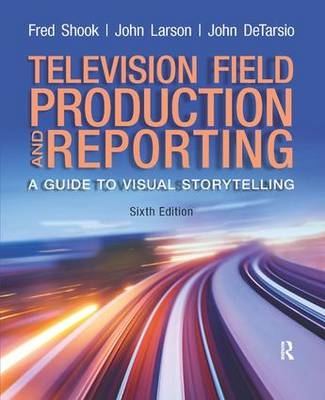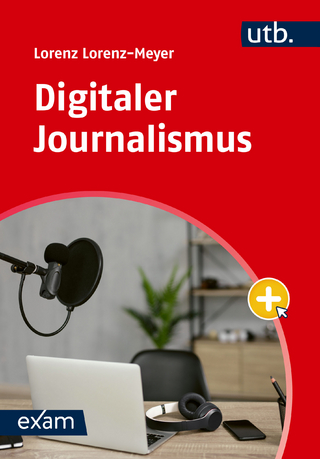
Television and Field Reporting
Routledge (Verlag)
978-0-205-11158-9 (ISBN)
- Titel erscheint in neuer Auflage
- Artikel merken
Fred Shook, Colorado State University, Fort Collins John Larson, NBC News John DeTarsio, DiTarsio Productions, Inc.
Preface
About the Author
Introduction: Television Is a Language
Chapter One: Telling the Visual Story
The Difference Between Visual Stories and Reports
Heart, Emotion, Demeanor
Placing the Human Perspective in Perspective
The Value of Pictorial Narrative
Silence As A Writing Tool
The Silent Language of the Senses
Putting It All Together
Culture Impacts Perception
How To Plan The Visual Story
The Best Stories Convey a Sense of Progression
Find Images that Convey a Clear Story Focus
Write the Pictures First
Reportorial Editing
Working As Part of a Team
Prove the Story’s Focus Visually
The Focus May Change
Look for a Story Focus in Spot-News Events
Tell Your Story through People
Strong Natural Sound Helps Tell the Story
Build In Surprises
Keep Sound Bites Short
Address the Larger Issue
Challenge Your Focus Statement
Video Packages are Factual Mini-Moives
The Lead
Provide Visual Proof for all Main Points
The Close
Be Hard on Yourself as a Writer
Write from the Visuals
Look For A Story While Capturing Uncontrolled Action
Look For the Larger Story
Chapter Two: The Visual Grammar of Motion Picture Photography
The Shot
The Sequence
Long Shot
Medium Shot
Close-Up
How the Basic Shots Work Together
Camera Movement
Pan
Moving Shot
Combination Shot
Tilt Shot
Tracking Shot
Trucking Shot
Dolly Shot
Stabilization of Shaky Images
Shots That Help Tell the Story
One Shots to Crowd Shots
Master Shot with Cut-Ins
Overlapping Action
Matched-Action Sequences Can Be Shot in Spot News
Jump Cuts
The Cutaway
The Motivated Cutaway
The Transition or Reveal Shot
Using Camera Movement to Enhance Storytelling
Point-Of-View Movement
Thinking Camera
How To Avoid The False Reverse
Vary Camera Angles
Photograph People at Eye Level
Contrast and Comparison
Composition
Chapter Three: Video Editing: The Invisible Art
Editing is Another Writing Tool
Toward a Philosophy of Editing
Everyone Is an Editor
The Cut
Choosing Edit Points
There Can Be No Matched Action without Overlapping Action
Cutting on Action or at Rest
Into-Frame/Out-of-Frame Action
Jump Cuts
Pop Cuts
Devices to Compress Time and Advance the Action
Parallel Cutting
Shot Order Impacts the Illusion of Continuity
Content Dictates Pace
Cutting to Condense Time
Composition Affects Pace
Screen Direction
Editing to Eliminate the False Reverse
The Transition Shot
Sound as a Transitional Device
Cold Cuts
Flash Cuts
Cutting to Leave Space for Audience Reaction
Communication Pays
Dissolves and Other Optical Effects
Chapter Four: Shooting Video in the Field
Composition Guidelines
The Rule of Thirds
Pointers for Wide Screen Composition
Use a Tripod Whenever Possible
The Handheld Camera
Balance the Camera
Use A Wide Stance
Control Breathing
Preplan Body Movement
Walk in Lockstep
Avoid Unplanned Camera Movement
How to Use the Zoom Lens
Avoid Calling Attention to the Zoom
Avoid Speed and Duration of Zoon to Story Mood and Pace
Recompose the Shot as you Zoom
Storytelling and Planning
Establish Communication in the Field
Think Before You Shoot
Shoot Sequences
Shoot and Move
Anticipate Action
Shoot Only the Shots You Need
Avoid Indiscriminate Shooting
Edit in the Camera
Shoot to Eliminate the False Reverse
Involve the Camera in the Action
Working with People
Avoid Distracting the Subject
Staging Versus Motivating
The One-Person Band
How to Shoot and Conduct Interviews Simultaneously
How to Photograph Your Own Standup
Shooting in Cold Weather
Safety First
Distancing
Safety in Numbers
Plan to Make Mistakes
On Returning to the Station
Chapter Five: Writing with Light
Photography Is the Art of Controlling Light
Light-Mounted Fitlers
Mixing Light Sources
Basic Lighting Patterns
The Role of Artificial Light
Key Light
Contrast Control
The Inverse-Square Law of Light
Backlight
Broadlighting and Short Lighting
Lighting for High Definition
Flat Lighting
Light Diffusion
Bounce Lighting
Exposure
Essential Lighting Equipment
Lighting in Sunlight
How to Light a News Conference
Setting Up Lights in Cooperation with Other Crews
Lighting Etiquette
Lighting Spot News at Night
Photographing Subjects with Dark Skin
Large-Scale Lighting
Cautions
Chapter Six: The Sound Track
How Microphones Work
Directional Patterns
On Choosing a Mike
Impedance
Frequency Response
Microphones for the Video Journalist
The Wireless Transmitter-Receiver
The Mixer
Essential Points for Audio
Techniques to Reduce Wind Noise
Be Aggressive
The Microphone Hears Differently
Sound Perspective
Stereo and Surround Sound
Covering News Conferences
Recording Group Discussions
The Two-Person Interview
Record Room Tone
The Seductive Quality of Nat Sound
Watch What You Say
Sound and Video Accessories
Chapter Seven: The Broadcast Interview: Shooting the Quotation Marks
Establish Trust
Practice Good Manners
The Most Important Interview Question
Save Your Questions for the Interview
Do Your Homework
How to Frame Interview Questions
Use a Wireless Microphone
The Art of Listening
Avoid the Easy Questions
Avoid Two-Part Questions
“How Do You Feel?”
Anticipate Questions the Viewers Would Ask
Practice the Fine Art of Hesitation
Pitch Reporting Opportunities
Prearrange Signals between Reporter and Photographer
How to React without Appearing to Agree
Retain Control of the Interview
Interviewing Children
The Talking Head
Influencing How Viewers Perceive the Subject
One-Eyed Talking Heads
Body Language
After the Interview Is Over
Interviews Allow Reporting through Direct Observation
Chapter Eight: Video Script Formats by Luan Akin
Reader
VTR VO (Voice-Over Video)
VTR VO (Voice-Over Video)VO/SOT/VO (VO SOT or A/B for Short)
Intros to Live Shots
Live Intros to Packages
Package Scripts
Reporter and Anchor Closes
The Case for Caps and LowerCase
Summary
Exercises
Chapter Nine: Writing the Package
Define Your Focus
Write the Beginning (Studio Lead-in)
Write the Package Lead
Write the Middle or Main Body
Write the Close
Preplanning the Package
Spot-News Packages
Set a High Standard for Packages
Use Natural Sound Liberally
Chapter Ten: Write Like a Storyteller by John Larson
Transmitting The Experience
Writing Your First Sentence
The Three Horses – Storytelling Tools for Video Stories
First Horse: Surprise
Second Horse: Quest
Third Horse: Character
Tips for Writing Strong Stories
Chapter Eleven: Video Journalism: Storytelling on Your Wosn by JohnLarson
The Big Picture
Size Matters–Bigger Is Not Always Better
Bottom Line
Starting Out, Over Or Up
Six Overlooked Tools For Video Journalists
Minute By Minute–One Man Band Lessons Learned in the Field
A Guide Tour: Lessons Learned
Chapter Twelve: How to Improve Your Storytelling Ability
Seek Gradual Improvement
Have a Story
Involve the Camera
Sequences Don't Advance the Story
Don't Try to Show All of New Zealand
Pursue Your Interest in People
Motivate Viewers to Watch
Develop Video Fluency
Know the Community
Curiosity Pays
See Beyond the Obvious
Show Audiences What They Missed
Help Viewers Experience The Story As You Did
Adapt Your Reporting to Story Demands
Reporting the Nonvisual Story
Personal Appearance and Conduct
Etiquette
Shooting and Reporting Spot News
Toward a News Philosophy
Chapter Thirteen: Live Shots and Remotes by Luan Akin
What Does It Take to “Go Live?”
Spot News
Television Live Shot Formats
Narration
Helicopter Live Shots
Live in the Newsroom
Live Graphics
Live/Anchor Intros
Reporter Close
Anchor Close
Why Go Live?
Why Not Go Live?
Phoners
Live Teases
Some Parting Advice
A Final Thought
Chapter Fourteen: Law and the Broadcast Journalist
Gathering the News
Libel
Invasion of privacy
Defamation
Use of the Word Alleged
Apparent Authority
Technology
Telephone Recordings
Subpoenas and Shield Laws
Access Laws
Fair Use
Chapter Fifteen: Journalistic Ethics
A Definition of Ethics
Effects of Competition
Situational Ethics
Licensing
Contract With the Public
At Issue: Image Manipulation
Case Studies in Ethical Dilemmas
Reverse-Angle Questions
Staged News Events
Reenactments
File Video
Material Provided from Outside Sources
Toward an Individual Code of Ethics
Appendix A: Shooting Video: The Basics
The Camera
The Lens
Appendix B: Improving Performance in Field Reporting
Developing the Qualities That Make You Interesting and Interested
Reasons For Standups
Seek Reaction
Communicate What You Feel about the Story
Delivering From the Studio
Put Experience into Your Reports
Multidimensional Reporting
Marking Copy
Learn How to Relax
Develop Conversational Delivery
Your Appearance
Field Lighting for HDTV
Let the Audience Know You as a Friend
Impact How People Perceive Your Sources
Posture Matters
Split-Focus Presentation
The Anchor Debrief
When You Are Before the Camera
How Reporters Evolve Into Anchors
Appendix C: The Assignment Editor and Producer: Architects of the Newscast
The Assignment Editor
Assignment Editors Help Conceptualize the Package
The Producer
Toward a News Philosophy
Teases
Help Make the Station a Regional Force
Improve Audio-Video linkage
Visuals
Freshen File Video
Use Talking Heads with Purpose
Weather and Sports
Glossary
Index
| Erscheint lt. Verlag | 13.3.2012 |
|---|---|
| Verlagsort | New York |
| Sprache | englisch |
| Maße | 187 x 232 mm |
| Gewicht | 520 g |
| Themenwelt | Sozialwissenschaften ► Kommunikation / Medien ► Journalistik |
| ISBN-10 | 0-205-11158-0 / 0205111580 |
| ISBN-13 | 978-0-205-11158-9 / 9780205111589 |
| Zustand | Neuware |
| Informationen gemäß Produktsicherheitsverordnung (GPSR) | |
| Haben Sie eine Frage zum Produkt? |
aus dem Bereich



